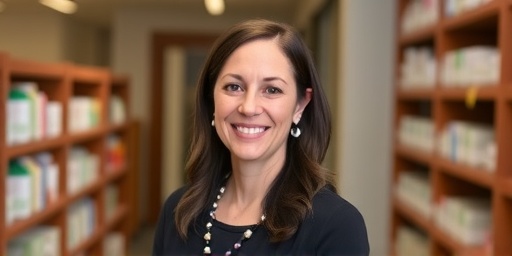In a move set to enhance patient care across rural Ohio, Ohio Hills Health Centers (OHHC) has appointed Dr. Emily Carter as its inaugural Pharmacy Director. This announcement comes just months ahead of the early 2026 opening of OHHC’s innovative closed-door Pharmacy, designed exclusively for its health, dental, and behavioral health patients. The facility promises home delivery options and substantial cost savings, addressing long-standing barriers in healthcare services for underserved communities.
Dr. Emily Carter Brings 15 Years of Pharmacy Expertise to OHHC
Dr. Emily Carter, PharmD, steps into the role with a robust background in community and hospital pharmacy operations. A graduate of Ohio State University’s College of Pharmacy, Carter has spent the last 15 years advancing patient care initiatives at major health systems, including a stint as lead pharmacist at Cleveland Clinic’s outpatient services. Her expertise in medication therapy management and telepharmacy has earned her accolades, such as the Ohio Pharmacists Association’s Innovator of the Year award in 2022.
“I’m thrilled to join OHHC at this pivotal moment,” Carter said in an exclusive interview. “Our closed-door pharmacy will integrate seamlessly with OHHC’s healthcare services, ensuring patients receive not just medications, but personalized support that reduces costs and improves adherence.”
Carter’s appointment addresses a critical need in OHHC’s network, which serves over 25,000 patients annually across 12 locations in southeastern Ohio. With a focus on rural health disparities, her leadership will prioritize high-risk populations, including those managing chronic conditions like diabetes and hypertension.
Closed-Door Pharmacy Model Targets Rural Access Gaps
The upcoming pharmacy at OHHC’s flagship center in Zanesville will operate as a closed-door facility, meaning no walk-in retail service. Instead, prescriptions from OHHC’s primary care, dental, and behavioral health providers will be filled centrally, with medications dispensed directly to patients via mail or curbside pickup. This model, inspired by successful programs at Veterans Affairs hospitals, minimizes overhead costs and passes cost savings directly to patients.
According to industry data from the National Community Pharmacists Association, traditional retail pharmacies mark up medications by 20-30%. OHHC’s approach eliminates this, projecting average savings of 40% per prescription. For a patient on multiple meds, this could mean hundreds of dollars saved annually.
- Key Features: 24/7 prescription processing, automated packaging for accuracy, and integration with electronic health records.
- Capacity: Initial rollout to handle 5,000 prescriptions monthly, scaling to 15,000 by 2027.
- Compliance: Fully HIPAA-secure with blockchain-tracked deliveries for controlled substances.
This isn’t just about convenience; it’s a response to Ohio’s rural pharmacy desert crisis. A 2023 study by the Ohio Department of Health revealed that 15% of rural counties lack a single pharmacy, forcing patients to drive 30+ miles for refills.
Home Delivery and Cost Savings Redefine Patient Convenience
At the heart of OHHC’s initiative are patient-centric innovations like free home delivery within a 50-mile radius, powered by partnerships with local couriers. For elderly or mobility-impaired patients, this eliminates transportation barriers—a common issue in Appalachia, where 22% of residents forgo medications due to access problems, per CDC data.
Cost savings are quantified: OHHC estimates patients will save $500-$1,200 yearly on generics and $300+ on brands through negotiated bulk pricing. “We’ve modeled this after 340B programs but tailored for community health centers,” explained OHHC CEO Mark Thompson. “It’s about equity in healthcare services.”
Early pilots at two OHHC sites have shown 92% patient satisfaction and a 25% drop in non-adherence rates. Behavioral health patients, often on complex regimens for opioid use disorder, stand to benefit most, with synchronized deliveries reducing relapse risks.
| Prescription Type | Traditional Cost | OHHC Projected Savings |
|---|---|---|
| Generic Statin | $40/month | 60% ($24 saved) |
| Antidepressant | $75/month | 45% ($34 saved) |
| Insulin | $300/month | 35% ($105 saved) |
Seamless Integration Boosts OHHC’s Holistic Healthcare Services
OHHC, a federally qualified health center network founded in 1978, has long championed integrated care. The new pharmacy will link directly with its 50+ providers, enabling real-time drug interaction checks and pharmacist consultations during appointments. Dental patients, for instance, will receive post-procedure antibiotics without delays, while behavioral health teams can monitor adherence via app-based reporting.
“This closes the loop on patient care,” said Dr. Sarah Jenkins, OHHC’s Chief Medical Officer. “We’ve seen fragmented services lead to poor outcomes; now, everything’s under one roof—virtually.”
Funding comes from a $2.5 million HRSA grant, supplemented by state opioid settlement funds. Construction began in Q3 2025, with robotic dispensing systems from Swisslog installed for precision.
Broader impact includes workforce development: OHHC plans to hire 12 pharmacists and technicians, many from local programs like Hocking College. This counters Ohio’s pharmacist shortage, projected at 10% by 2030 per the Bureau of Labor Statistics.
Stakeholders Rally Behind OHHC’s Pharmacy Vision for Rural Ohio
Community leaders are buzzing. “OHHC’s pharmacy is a game-changer for Muskingum County,” said Zanesville Mayor Jeffrey M. Tarter. “It tackles affordability head-on amid inflation pressures.”
The Ohio State Medical Association echoed support: “Integrated models like this exemplify forward-thinking healthcare services,” stated President Dr. Ronald R. Evens. Patient advocates, including AARP Ohio, highlight cost savings for seniors, who comprise 18% of OHHC’s base.
Challenges remain, such as regulatory hurdles for controlled substances and cybersecurity, but Carter’s team is proactive. Pilot data shows zero delivery errors in 1,000 shipments.
Looking ahead, OHHC eyes expansion to all 12 sites by 2028, potentially serving 50,000 patients. Partnerships with telehealth giants like Teladoc could enable nationwide delivery for relocated patients. As Ohio grapples with post-pandemic recovery, this pharmacy positions OHHC as a rural health pioneer, promising sustained improvements in patient care, adherence, and equity.
Dr. Carter concluded optimistically: “By 2026, we’ll not only fill prescriptions—we’ll transform lives.” Stakeholders will watch closely as opening day approaches, marking a new era for accessible healthcare services in the Ohio Hills.









